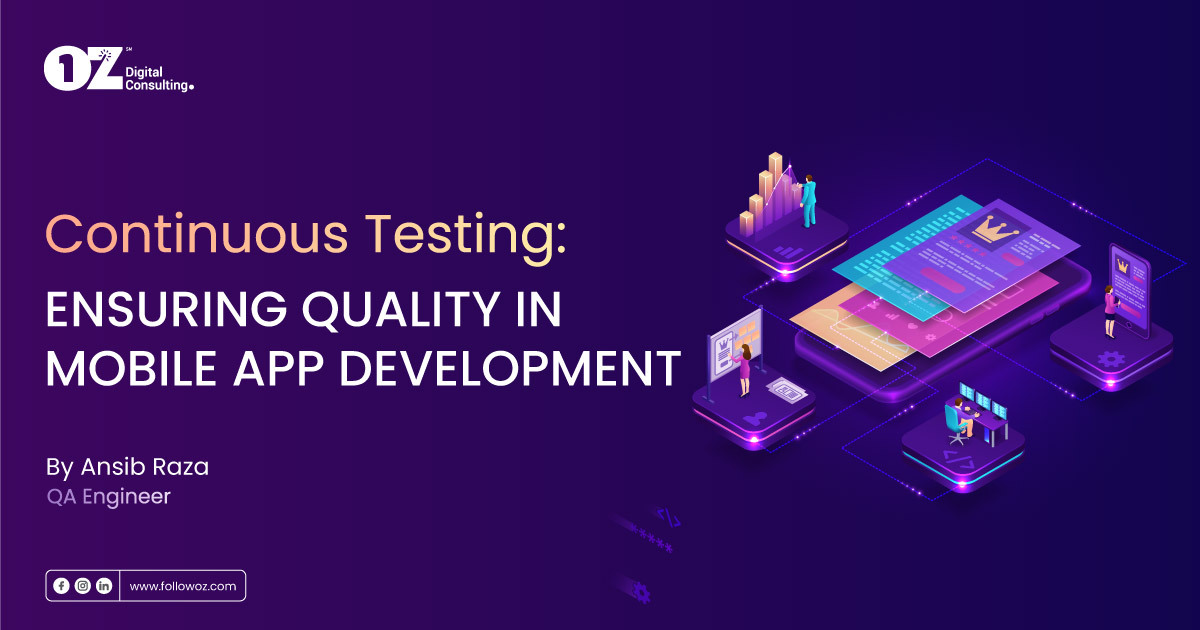By Ansib Raza, QA Engineer
In an age in which mobile apps have revolutionized our daily lives, workplaces, and interpersonal relations, it is now more important than ever to provide a seamless user experience.
How?
By continuously testing and improving app performance, functionality, and usability.
When properly incorporated into the mobile app development process, this practice provides numerous benefits and facilitates the development of high-performing, reliable apps.
Read on to learn how to get yourself out on the cutting edge of the continuous testing revolution.
Benefits of Continuous Testing
Here are a few of the most foundational benefits of continuous testing for apps…
- Early Detection and Resolution of Defects. Testing at frequent intervals throughout the development lifecycle allows for the detection of problems at an early, less expensive stage in the process. Taking this preventative measure reduces the time and trouble of fixing bugs in the final stages of development.
- Enhanced Quality. By breaking down the app into its component parts, designers can continuously monitor the performance and functionality of software while guaranteeing that it all works together seamlessly and efficiently.
- Faster Time-to-Market. By reducing the length of the development cycle—and ferreting out potential bugs more quickly—continuous testing speeds up the delivery of features to customers and decreases the product’s time to market.
- Risk Mitigation. Continuous testing aids in spotting vulnerabilities and threats throughout the development process. By conducting these checks on a regular basis, teams can prevent major problems from arising and lessen the impact of any that may occur.
- Improved User Experience. Continuous testing guarantees that the app’s features all work as they should, providing a consistent experience for the user. It aids the development of apps that not only live up to but also exceed users’ expectations by placing a premium on quality and performance.
Key Components of Continuous Testing
But what, precisely, does continuous testing…test?
Here’s a breakdown:
- Unit Testing. Separately testing each module or “unit” of an application ensures each element of an app works correctly in every scenario by isolating it from the rest of the program and rigorously testing it. Popular frameworks for unit testing include JUnit, NUnit, and XCTest.
- Integration Testing. When testing an application’s integration, testers look for any place where separate parts or modules interact with one another. The goal of this testing is to find any problems that may arise from the interaction of multiple components.
- System Testing. This entails verifying the app’s features and performance across a variety of platforms and hardware configurations.
- Regression Testing. Regression testing is done after changes have been made to the software—such as adding new features or fixing bugs—to ensure that the changes haven’t broken any of the previously tested functionality. Automated testing tools, after all, can quickly and easily rerun previously defined test cases on the updated software.
- Acceptance Testing. Acceptance testing—also known as User Acceptance Testing or UAT—is the final stage of the testing process, ensuring that the system is ready for release. Here, the software is put through its paces by its end users to make sure it can perform as expected under real-world conditions.
Tools and Technologies
Continuous testing requires a powerful arsenal of techniques. XCTest is well-liked on iOS, but when it comes to unit and integration testing, JUnit and Espresso shine on Android. For automated UI testing, two popular frameworks are Appium and Selenium. Jenkins and Travis CI simplify the integration testing process by automating the build and testing steps.
To ensure APIs function as expected within an app, developers frequently utilize Postman as a testing tool. Finally, cloud-based testing systems like BrowserStack and Sauce Labs supply the necessary infrastructure for testing apps across devices and environments.
Remember, the right equipment is essential for successful continuous testing.
Implementing Continuous Testing
Ready to begin your own continuous testing regime?
Here is a concise guide to how to do just that…
- Define the Testing Strategy: Determine the types of tests that need to be conducted and when. Part of this process involves settling on a mix of automated and hand-run tests.
- Select the Right Tools: Select testing tools that fit in with your development setting and support your testing strategy.
- Integrate Testing into the Development Process: Implementing automated test runs after each code change is a crucial part of a continuous testing strategy.
- Foster a Culture of Continuous Improvement: Inspire your development staff to adopt a quality assurance and continuous improvement mentality.
Overcoming Continuous Testing Hurdles
Will there be challenges?
Of course!
But if you know what to expect, it’s easy to prepare.
Some of the most typical problems that arise during continuous testing implementation include…
- Choosing What to Automate. Determining which test cases should be automated is a crucial step in adopting continuous testing. However, tests that require intricate human interaction or subjective judgment might not be amenable to automation. In general, plan to automate tests that are either run frequently or cover important parts of the app.
- Maintaining and Updating Test Scripts. A large number of test scripts must be kept up to date and maintained for continuous testing. Updated or new test cases should be made to cover new features and functionality as the app develops. Keeping up with these revisions will require a methodical strategy and constant effort.
- Nurturing the Right Infrastructure and Environment. A reliable and scalable testing environment that can support a high volume of simultaneous tests is essential for continuous testing. When testing mobile apps on a wide variety of devices, OSes, and network conditions, it can be especially difficult to set up and maintain such an environment.
- Lack of Necessary Skills and Knowledge. A thorough understanding of testing methodologies and expertise with various testing tools and technologies are essential for effective continuous testing. These abilities are crucial for the successful implementation of continuous testing. To overcome this obstacle, it is crucial to train and educate development and testing teams.
- Balancing Speed and Quality. In order to prioritize speed and frequent releases, continuous testing is frequently implemented as part of a larger DevOps or Agile approach. Finding a happy medium between this urgency and the need for thorough testing can be difficult. Risk-based testing, in which the importance of specific tests is determined by the level of danger they pose, is one approach that can be used to overcome this difficulty.
- Getting Test Data Right. It can be difficult to create and manage test data for a wide variety of test cases. Another layer of complexity is added to the continuous testing process when it must be ensured that tests have access to the necessary data when they need it while also maintaining data privacy and compliance.
The Mindset Shift Toward Continuous Collaboration
The continuous testing mindset sees testing as an iterative process rather than a final checkpoint in the software development lifecycle. All stages of development are devoted to rigorous quality testing.
Those who work with this mindset are more likely to spot and fix issues as soon as they arise. It fosters an atmosphere where feedback on how to enhance the app is welcomed and incorporated quickly.
Further, collaborative testing is crucial to successful development, simplifying communication between parties to create a higher likelihood that together they will create a high-quality, fully functional app—even as team members are inspired to share their knowledge and gain insight from others, which improves everyone’s performance.
Your Next Steps
To find out more about the OZ suite of modern application development services click here or reach out today.
You can also download a copy of our free e-Book, Future App: Overcoming the 3 Major Challenges to Unlocking the Power & Promise of Today’s Modern Applications.



